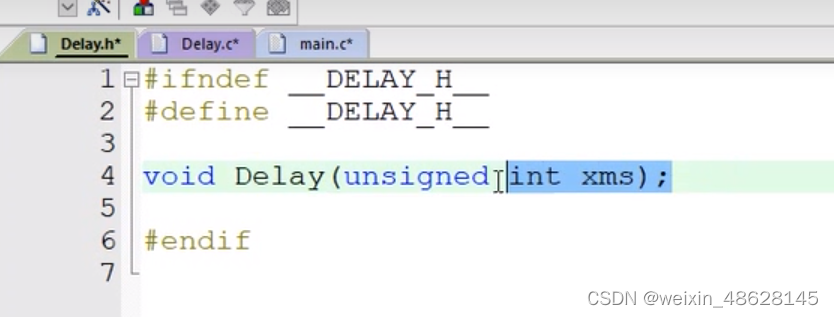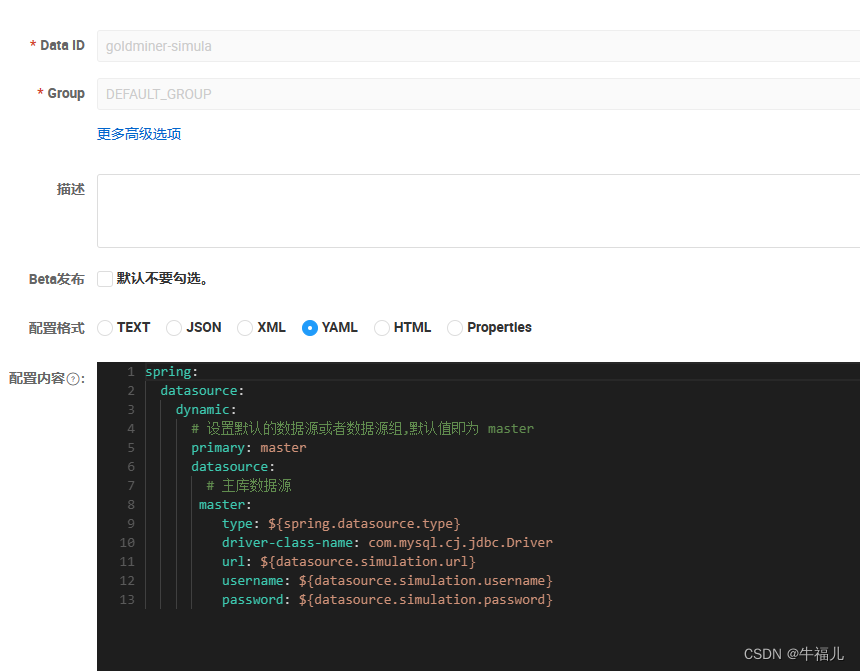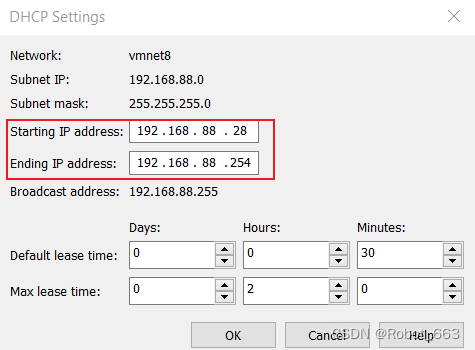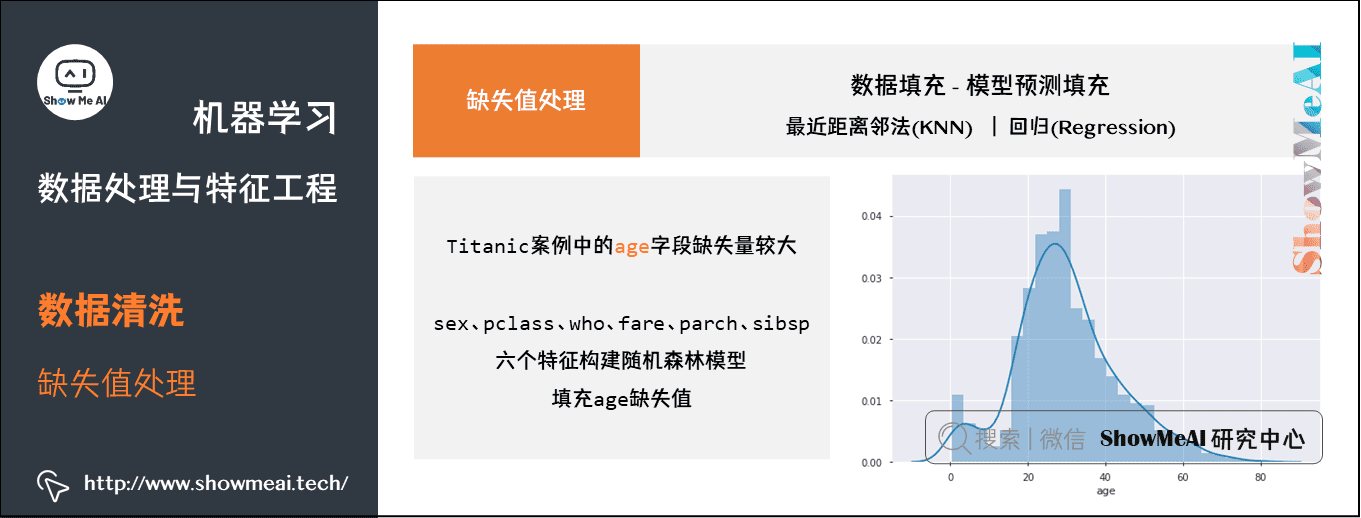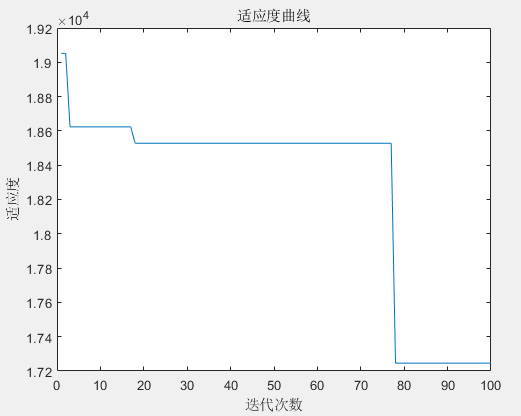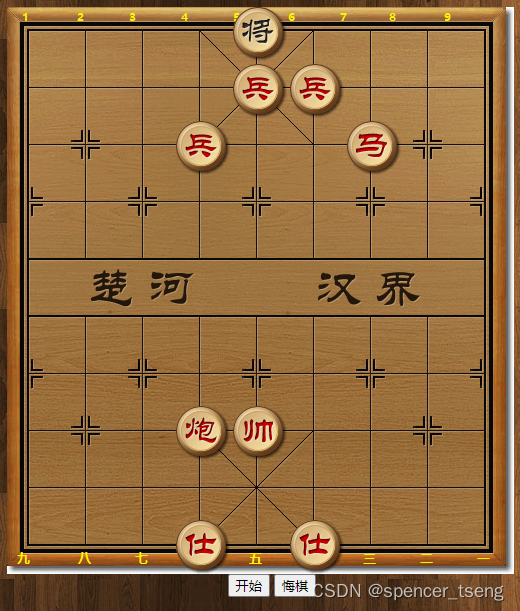1、宏
1.1 为什么要使用宏
1、提高代码的可读性和可维护性2、避免函数调用,提高程序效率
1.2 什么是宏
1.3 宏的定义
#define WIDTH 960
#include <stdio.h>
#include <stdlib.h>
#define _width 1024 //宏命名规则同变量名
#define ADDR "中华人民共和国湖南\
省平江县"
int main(void) {
printf("width: %d\n", _width);
printf("我的祖籍: %s\n", ADDR);
system("pause");
return 0;
}运行结果:
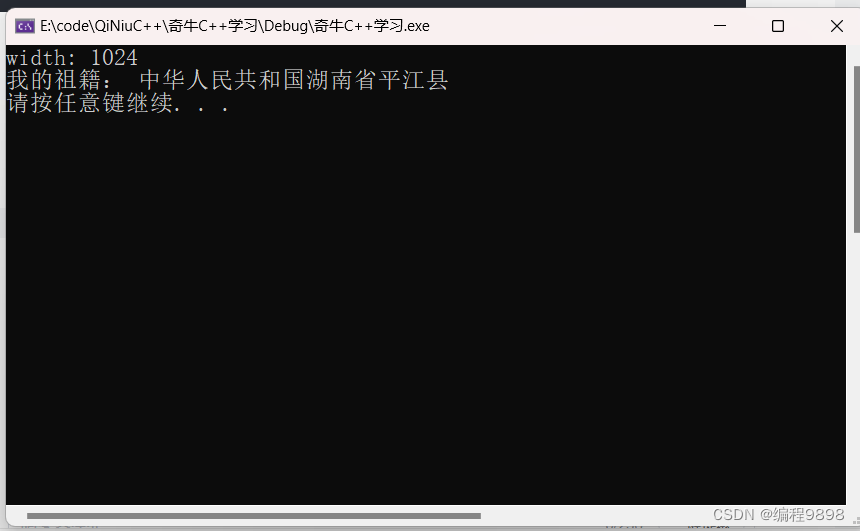
注意:在定义宏的时候,如果要写宏不止一行,则在结尾加反斜线符号使得多行能连接上,如:#define HELLO "hello \
the world"
1.4 宏的使用
1. 不带参数的宏2. 在宏中使用参数
#define SQUARE(x)1 (x)*(x)#define SQUARE(x)2 x*x
#include <stdio.h>
#include <stdlib.h>
#define SQUARE1(x) (x)*(x)
#define SQUARE2(x) x*x
int main() {
printf("%d\n", SQUARE1(1 + 2));
printf("%d\n", SQUARE2(1 + 2));
}运行结果:
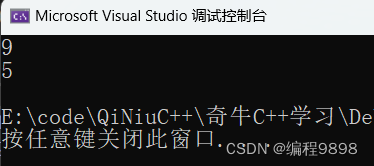
注意第一种宏它的替换是:(1+2)*(1+2)=9
第二种宏它的替换是:1+2*1+2=5,替换后遵循四则运算,先算乘法再算加法。
#include <stdio.h>
#include <stdlib.h>
//不带参数的宏
#define _width 1024
#define ADDR "中华人民共和国湖南\
省平江县"
#define SQUARE(x) (x)*(x)
#define MAX(x,y) x>y?x:y
int main(void) {
printf("width: %d\n", _width); // 宏展开相当于1024
printf("width: %d\n", 1024);
printf("我的祖籍: %s\n", ADDR);
int i = 10;
int j = SQUARE(i); // 宏展开 j = i*i;
printf("j: %d\n", j);
printf("MAX(i,j):%d\n", MAX(i, j)); //宏展开
printf("MAX(i,j):%d\n", i > j ? i : j);
int z = SQUARE(2 + 3); // (2+3)*(2+3) = 25
printf("z: %d\n", z);
system("pause");
return 0;
}运行结果:
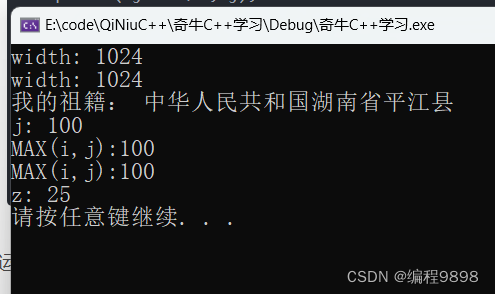
再看下面这个代码有什么问题:

代码已经报错了,但是为什么,请注意,这里的王鹏程它并不是一个字符串,有人认为代码没错,打印的就是王鹏程啊,但是这里王鹏程不是字符串,他只是一个没有类型的量。
2、结构体
2.1 为什么要使用“结构”(结构体)
2.2 什么是“结构”
2.3 结构的定义
struct 结构名 {成员类型成员名;成员类型成员名;};
注意结构体的定义,最后大括号外面那个分号不能少!
实例:
struct student {char name[16];intage;char tel[12];};
1)要以 struct 开头2)最后要使用分号3)各成员之间用分号隔开
2.4 结构的初始化
#include <stdio.h>
#include <stdlib.h>
#include <string.h>
//结构,就是程序员自定义的一种“数据类型”
struct student {
char name[16];
int age;
char tel[12];
};
//结构体包含结构体的情况,即嵌套
struct _class {
struct student rock;
struct student martin;
struct student zsf;
};
int main(void) {
//结构体的初始化
//方式一 定义的时候初始化所有的属性
struct student rock = { "Rock", 38, "******" };
printf("rock 的姓名: %s 年龄: %d 电话: %s\n", rock.name, rock.age,rock.tel);
//方式二 定义的时候我们可以指定初始化的属性 VS/VC 不支持,但 gcc 是支持的
//struct student s1 ={.name="张三丰",.age = 100};
//方式三 单独初始化每一个属性
struct student s2;
strcpy(s2.name, "杨过");
s2.age = 40;
s2.tel[0] = '\0';
printf("杨过的姓名: %s 年龄: %d 电话: %s\n", s2.name, s2.age,s2.tel);
//结构体中含有结构体
struct _class c1 = { {"Rock", 38, "******"},{"Martin", 38,"18684518289"},{"张三丰",100,""} };
printf("c1 班 martin 同学的姓名: %s 年龄: %d 电话: %s\n",c1.martin.name, c1.martin.age, c1.martin.tel);
system("pause");
return 0;
}注意:第二种初始化方式在VS编译器中不支持,因此不同编译器还是有差别的。
运行结果:

2.5 结构体的使用
#include <stdio.h>
#include <stdlib.h>
#include <string.h>
struct student {
char name[16];
int age;
};
int main(void) {
struct student s1, s2;
printf("请输入第一个学生的姓名:\n");
scanf_s("%s", s1.name, sizeof(s1.name));
printf("请输入第一个学生的年龄:\n");
scanf("%d", &s1.age);
printf("第一个学生的姓名: %s, 年龄: %d\n", s1.name, s1.age);
//结构体的小秘密,结构体变量之间可以直接赋值
s2 = s1;
printf("第二个学生的姓名: %s, 年龄: %d\n", s2.name, s2.age);
//char c1[16] = { "martin" }, c2[16];
//c2 = c1; //数组不能直接赋值
system("pause");
return 0;
}运行结果:
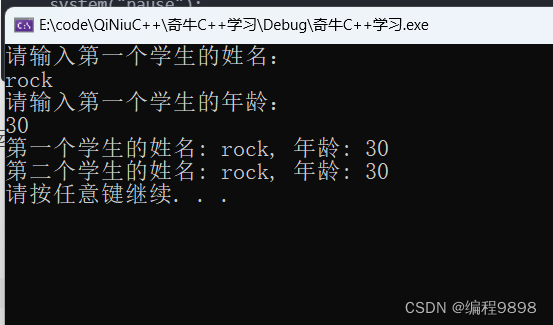
注意:结构体变量之间可以赋值,但是数组之间不能赋值,如代码最后两行,如果取消掉注释就会报错。数组之间不能直接赋值!!
结构体之间还可以通过memcpy( )函数赋值:
#include <stdio.h>
#include <stdlib.h>
#include <string.h>
struct student {
char name[16];
int age;
};
int main(void) {
struct student s1, s2;
printf("请输入第一个学生的姓名:\n");
scanf_s("%s", s1.name, sizeof(s1.name));
printf("请输入第一个学生的年龄:\n");
scanf("%d", &s1.age);
printf("第一个学生的姓名: %s, 年龄: %d\n", s1.name, s1.age);
memcpy(&s2, &s1, sizeof(struct student));
printf("第二个学生的姓名: %s, 年龄: %d\n", s2.name, s2.age);
}运行结果:
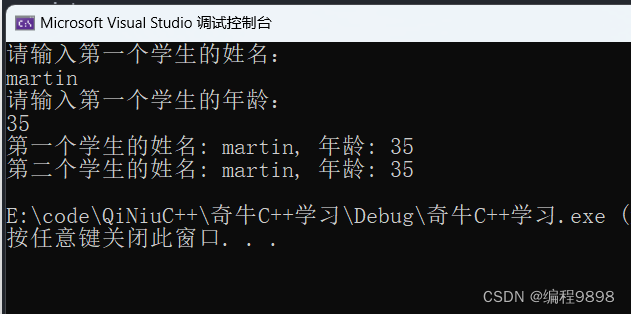
2.6 结构体数组
结构体数组的定义:
struct 结构名 变量名 [ 数组大小 ]
#include <stdio.h>
#include <stdlib.h>
#include <string.h>
struct student {
char name[16];
int age;
};
int main(void) {
struct student s[2];
printf("请输入第一个学生的姓名:\n");
scanf_s("%s", s[0].name, sizeof(s[0].name));
printf("请输入第一个学生的年龄:\n");
scanf("%d", &s[0].age);
printf("第一个学生的姓名: %s, 年龄: %d\n", s[0].name, s[0].age);
//结构体的小秘密,结构体变量之间可以直接赋值
s[1] = s[0];
memcpy(&s[1], &s[0], sizeof(struct student));
printf("第二个学生的姓名: %s, 年龄: %d\n", s[1].name, s[1].age);
system("pause");
return 0;
}运行结果:

结构体数组的定义和普通数组定义完全一样。每个数组元素就相当于一个普通的变量。
2.7 指向结构体的指针
使用结构体变量址指针访问结构体成员要使用 -> 符号
#include <stdio.h>
#include <stdlib.h>
#include <string.h>
struct _friend {
char name[32];
char sex; // m - 男 f - 女
int age;
};
int main(void) {
struct _friend girl = { "小龙女", 'f', 18 };
struct _friend* my_girl = &girl;
printf("小龙女的名字:%s, 性别:%s 年龄:%d\n", girl.name,girl.sex == 'm' ? "男" : "女", girl.age);
//指针访问结构体变量的成员,有两种方式
//方式 1. 直接解引
printf("小龙女的名字:%s, 性别:%s 年龄:%d\n", (*my_girl).name,
(*my_girl).sex == 'm' ? "男" : "女", (*my_girl).age);
//方式 2. 直接使用指针访问 ->
printf("小龙女的名字:%s, 性别:%s 年龄:%d\n", my_girl->name,my_girl->sex == 'm' ? "男" : "女", my_girl->age);
system("pause");
return 0;
}运行结果:

这块代码就是掌握结构体普通解引用和指针直接解引用的操作。实际开发中我们常用 -> 符通过指针去访问结构体指针变量的成员。
2.8 使用结构体传递值
#include <stdio.h>
#include <stdlib.h>
#include <string.h>
struct programer {
char name[32];
int age;
int salary;
};
//形参是结构体变量,值传递
struct programer add_salary(struct programer p, int num) {
p.salary += num;
return p;
}
//形参使用结构体指针
void add_salary1(struct programer* p, int num) {
if (!p) return;
p->salary += num;
}
//形参使用引用
void add_salary2(struct programer& p, int num) {
p.salary += num;
}
//形参是结构体变量,值传递,返回引用
struct programer& add_salary3(struct programer p, int num) {
p.salary += num;
return p;
}
int main(void) {
struct programer xiaoniu;
strcpy(xiaoniu.name, "小牛");
xiaoniu.age = 28;
xiaoniu.salary = 20000;
//结构体变量做为参数传值是值传递,和 int 等基本类型一样
xiaoniu = add_salary(xiaoniu, 5000);
printf("姓名: %s, 年龄: %d, 薪水: %d\n", xiaoniu.name, xiaoniu.age, xiaoniu.salary);
//指针传值
add_salary1(&xiaoniu, 5000);
printf("姓名: %s, 年龄: %d, 薪水: %d\n", xiaoniu.name, xiaoniu.age, xiaoniu.salary);
//引用传值
add_salary2(xiaoniu, 10000);
printf("姓名: %s, 年龄: %d, 薪水: %d\n", xiaoniu.name, xiaoniu.age, xiaoniu.salary);
//返回引用
xiaoniu = add_salary3(xiaoniu, 20000);
printf("姓名: %s, 年龄: %d, 薪水: %d\n", xiaoniu.name, xiaoniu.age,xiaoniu.salary);
}运行结果:

当是值传递时,和普通数据类型一样,传递的是一份临时拷贝,对于结构体传递值,我们一般用指针和引用,因为我们知道,函数形参是在栈区,而栈区有限,结构体比较占用内存,因此值传递效率很低。
一般不建议把结构体直接作为函数参数。 因为结构体的 size 比较大,直接传递,消耗性能!解决方案 : (使用指针和引用,优先使用引用)


